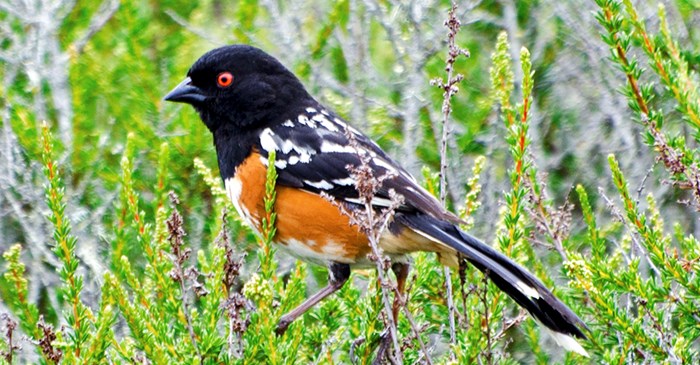Out in the scrubby, open habitat of the Western U.S., the Spotted Towhee uses a unique move that helps them find food. With a backwards hop, these ground foragers will "scratch" back the leaf litter and then dart forward to snap up the newly exposed insects.
These striking birds are also identifiable by their black upperparts with white spots, rusty orange sides, white bellies and stout black beaks. They’re chunky and rounded in shape, similar in size to a robin, and have long tails. When they are in flight, white in the “corners” of their tails may be visible.
The Spotted Towhee is a resident throughout the Western U.S. But populations that summer in Idaho, Montana, Wyoming and the Western Dakotas are short distance migrators in the fall to reach more mild winter temperatures.
Until 1995, the Spotted Towhee and the Eastern Towhee were considered the same species, known as the Rufous-sided Towhee. Though very similar in appearance and behavior — both have orange-colored sides and scratch leaf litter in search of bugs — they live on opposite sides of the country. You can tell them apart by appearance and song. The Eastern Towhee, which has no spots, is famous for its song, “drink your teeeeea.” The Spotted Towhee’s song is harsher and sounds like “sweet-sweet teeeeea!”
During the warm weather months, the Spotted Towhee focuses its foraging efforts on insects: beetles, grasshoppers, crickets, ladybugs, caterpillars, moths, bees, wasps and also spiders. In the winter, they’ll be on the lookout for seeds and berries that are clinging to the plants.
Spotted Towhees will also visit backyard feeders, especially if you live near their habitat with plenty of brush and shrubs. You can welcome them to your yard by sprinkling wild bird food on the ground. The classic blend in Lyric Wild Bird Mix is free of fillers found in cheaper blends and is packed with high-energy morsels birds love, including sunflower seeds, safflower, white millet, peanuts and cracked corn that these ground feeders love.
